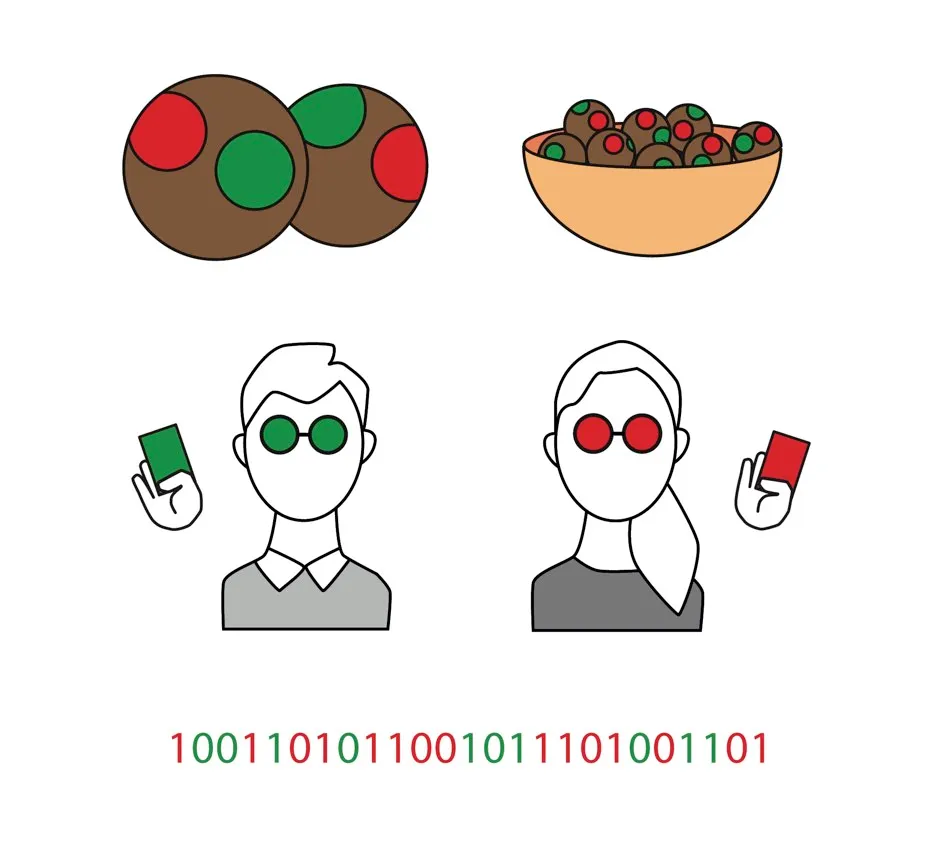The concepts behind quantum cryptography might at first seem complicated, but an Austrian physicist called Karl Svozil has devised a stage show that explains how a system works using actors, two pairs of coloured spectacles – one red and one green – and a bowl of foil-wrapped chocolate balls.
Svozil’s inaugural performance took place in October 2005 at the University of Technology in Vienna. On the stage, he arranged two actors, playing the parts of Alice (who sends the message) and Bob (who receives it), and a bowl of chocolates wrapped in black foil.
On each of the chocolates were two stickers: a red sticker with either 0 on it, representing a horizontally polarised photon, or 1, representing a vertically polarised photon; and a green sticker with either 0, representing a right diagonally polarised photon, or 1, to represent a left diagonally polarised photon.
Read more:
- Should you invest in cryptocurrency?
- Frozen heads and future fortunes: what is the cost of digital information?
- 10 of the most mysterious codes and ciphers in history
When the show began, Alice flipped a coin to decide which glasses to wear. Let’s say she got the green pair. This represents the polarisation scheme she is using to send that photon.
Alice took a random chocolate ball out of the bowl – remember that each ball has two stickers on it, one green, one red. The green glasses meant she could only see the numbers written on red stickers, and not those written on the green stickers. On a blackboard she wrote down the colour glasses she used, and the number she could see on the chocolate. A member of the audience then took on the role of a photon, shuttling the chocolate ball from Alice to Bob.
Next, Bob flipped a coin to choose a pair of glasses. Let’s say he got the red pair. He took a look at the ball and made a note of what number he could see, and what colour glasses he used. If he used the same colour glasses as Alice, he would see the same number.
After receiving the chocolate, Bob used a red or green flag to tell Alice what colour glasses he used. Alice let Bob know via her own flag what colour her glasses were. At no point did they communicate what symbol was written on the ball. If the colour of their flags matched, they kept the number, otherwise they discarded the entry.

Because Bob only wrote down his numbers if he had used the same glasses as Alice, after the whole process was repeated several times, the two of them had written down an identical series of 0s and 1s. They compared just a couple of the symbols to make sure an eavesdropper hadn’t been listening in, and, finding all was well, they had a perfectly secure random key they could use for a host of cryptographic applications.
The show was a great hit with the non-specialist audience who watched it, Svozil remembers. More importantly, perhaps, they came away from the experience having learned that although the physics behind quantum cryptography is unfamiliar, the procedure itself is as easily digested as a box of chocolates.
This is an extract from The Story of Codes: The History of Secret Communication by Stephen Pincock and Mark Frary (£19.95, Modern Books)
